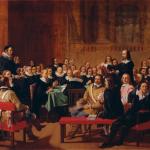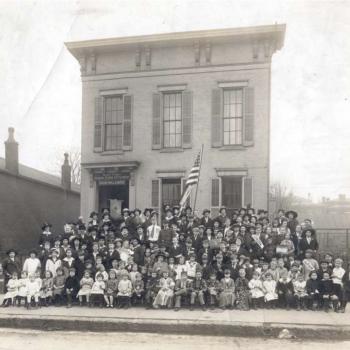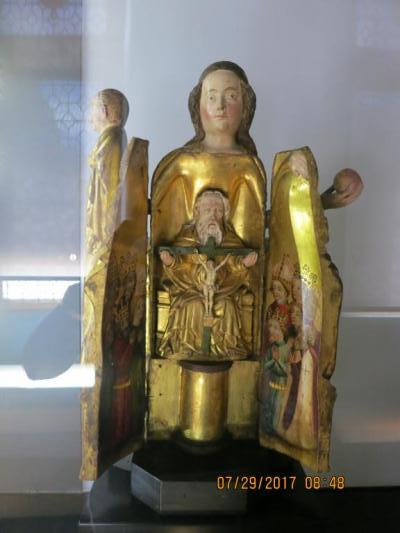
I honestly couldn’t decide what to write for today. Should I tackle Kevin DeYoung’s Desiring God article, or Al Mohler declaring that “pastor” in the Baptist Faith and Message 2000 excludes women from pastoral roles (not just senior/lead pastor), or build on Diana Butler Bass’s extraordinary sermon highlighting the even more extraordinary research of Elizabeth (Libbie) Schrader? Instead of making a choice, I decided to write on everything in a new series, “Death to the Patriarchy! How Medieval Christianity Can Help Evangelical Women.” This series will continue themes from The Making of Biblical Womanhood, highlight more of my own research in medieval sermons (including some of my published articles and forthcoming paperback of my first book The Pastoral Care of Women in Late Medieval England), and give you a taste for what is to come in my next two books. Today, in the inaugural installment (drawn from lectures I gave last year at Notre Dame and Georgetown College), I take you on a trip down my own recent memory lane about complementarian theology that minimizes the feminine face of God. As always, I’ll show you the historical evidence and you can decide how much it matters. I am indebted to Kevin DeYoung for inspiring the title of this new series.
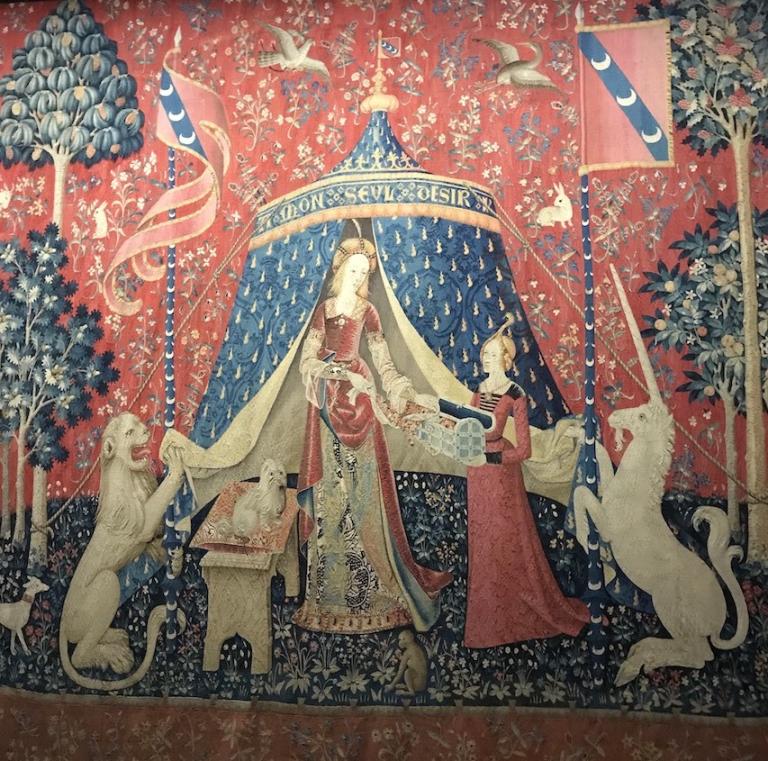
It was 2017 when I first saw the Shrine Madonna in the Cluny Museum—a monastic medieval mansion in Paris repurposed as a modern museum. I was in the unicorn tapestry room with my daughter when I heard my husband call out. I found him standing in front of the glass case. “Have you seen this?” he asked me, pointing at the figure of a woman, cased in glass, and split down the middle. Golden robes flowed from her body. In one hand she held an apple; her other arm encircled the Christ child. She was Mary, the mother of God, and inside her womb—displayed for all to see—rested the Godhead: God the Father, God the Son, and God the Holy Spirit. Is it any wonder this image startled my husband’s modern Baptist eyes? Each aspect of the image was familiar—the Virgin Mary, the symbol of the apple contrasted with the Christ Child, the Trinity enthroned. But taken together, indeed, taken together inside the body of Mary, made them less familiar. It certainly seemed to give the idea of the “Mother of God” a more robust meaning.
I knew what a Shrine Madonna was. They became popular during the thirteenth-century and, according to Elina Gertsman, remained popular throughout the late Middle Ages—proliferating in monasteries and cathedrals. But this image in the Cluny museum was the first one I think I really saw.
I could see my husband’s reflection in the glass almost merging with mine as we stood there, side by side, mesmerized by the image. The moment was broken all too soon when our children found us, but I remember the thought I had as my daughter dragged me away (she was smitten with the jeweled reliquaries). You see, I’d recently written a conference paper in which I used a 2012 remark made by John Piper. He was speaking at a pastor’s conference in Minneapolis; and his words were almost as striking as the Shrine Madonna–but for very different reasons. I’ve discussed his words before on this blog, but they are just so telling. Listen to what Piper said:
“God revealed Himself in the Bible pervasively as king not queen, father not mother. Second person of the Trinity is revealed as the eternal Son not daughter; the Father and the Son create man and woman in His image and give them the name man, the name of the male. God appoints all the priests in the Old Testament to be men; the Son of God came into the world to be a man; He chose 12 men to be His apostles; the apostles appointed that the overseers of the Church be men; and when it came to marriage they taught that the husband should be the head. Now, from all of that I conclude that God has given Christianity a masculine feel. And being God, a God of love, He has done that for our maximum flourishing both male and female.”
“God has given Christianity a masculine feel.” How ironic those words sounded to me as I thought about the medieval shrine Madonna—a woman whose body literally birthed salvation.
Yet, for the thousands upon thousands of evangelical Christians who flock to John Piper’s website every day, who listen uncritically to the teachings of (mostly white) men like him, the medieval roots of our faith—especially their emphasis on the feminine side of Christianity–are long forgotten.
Shrine Madonnas represent—in a very powerful way—the feminine face of God. Not only did God come through the body of a woman, but God also identifies as a woman—a mother. Feminine imagery isn’t just about Mary, the mother of Jesus. Feminine imagery is also how biblical text identifies God. Did you know that in Isaiah 42:14 God identifies as a mother in childbirth? “For a long time I have kept silent, I have been quiet and held myself back. But now, like a woman in childbirth, I cry out, I gasp and pant.” Did you know that in Isaiah 66:12-13 God identifies as a mother comforting her children? “For this is what the Lord says: ‘I will extend peace to her (Jerusalem) like a river, and wealth of nations like a flooding stream; you will nurse and be carried on her arm and dandled on her knees; As a mother comforts her child, so I will comfort you.”
Indeed, once you see the feminine imagery in the Old Testament, you cannot unsee it. From Hosea 11 where God is described as loving Israel like a son, lifting the little child Israel up and nursing him with a mother’s body (Hosea 11:3-4), to Deuteronomy where God is described as giving birth to the Israelite people, to Psalm 131:2 where God is so clearly imagined as a mother to our souls: “But I have calmed and quieted my soul, like a weaned child with its mother; my soul is like the weaned child that is with me.”
Nor does feminine imagery for God end in the Old Testament. Undergraduate student Abby Dolan (from Oklahoma Christian University) wrote, in a paper she published with the Priscilla Papers in 2018, that even such common phrases as “born of God” (1 John 4:7) or the image of God nursing us as newborn babes (1 Peter 2:2-3) evoke maternal imagery. Not to mention we all know that Jesus identifies as a mother in Matthew 21:37: “Jerusalem, Jerusalem, you who kill the prophets and stone those sent to you, how often I have longed to gather your children together, as a hen gathers her chicks under her wings.”
The biblical texts are clear. God is more often identified as Father in the Bible, but that doesn’t minimize the significance of the references to God as Mother.
Of course, we know that these images of God as mother, as well as God as father, are symbolic. We can’t accurately frame God in our human language because God isn’t human–we are made in the image of God, not the other way around. I love how Abby Dolan, even as an undergraduate student, recognized that how we reference God doesn’t change God; it only changes how we perceive God.
Isn’t it striking that the same medieval world that produced the shrine Madonna also spoke comfortably about God as Mother? Isn’t it also striking that modern evangelicals who downplay the significance of God choosing a woman to birth salvation also downplay the significance of maternal imagery used for God? Instead they double down on paternal imagery because it buttresses their claim of masculine authority.
Now, I confess, the extent of evangelical amnesia about the biblical portrayal of God as mother often surprises me. Just last November, as so many of you might remember, it became clear to me in a very personal way how much evangelicals have forgotten the feminine face of God. For those of you who missed it, this is what happened: the Council for Biblical Manhood and Womanhood had targeted me, along with Kristin Kobes Du Mez, in their November newsletter. Listen to some of what they wrote: “What is at stake is not just how we order our homes and churches according to God’s revelation. What is at stake is nothing short of God’s revelation itself…Not only is the image of God under attack through attempts to erase God’s design in male-female complementarity in gender-neutral pronouns and non-binary identities, now a growing movement gaining momentum that is attempting to rewrite God’s self-revelation, no longer worshipping him according to how he revealed himself to the world through his word.”
What does this mean?
It means that the CBMW is upset about folk not referencing God as a man. From their perspective, referencing God as “mother” and/or using feminine pronouns for God disrupts God’s “self-revelation”. The growing comfort among Christians to perceive God as mother, they contend, is proof that their “work is far from done.”
For so many evangelical Christians, as represented by the CBMW, the only orthodox language to reference God is masculine. Except it isn’t.
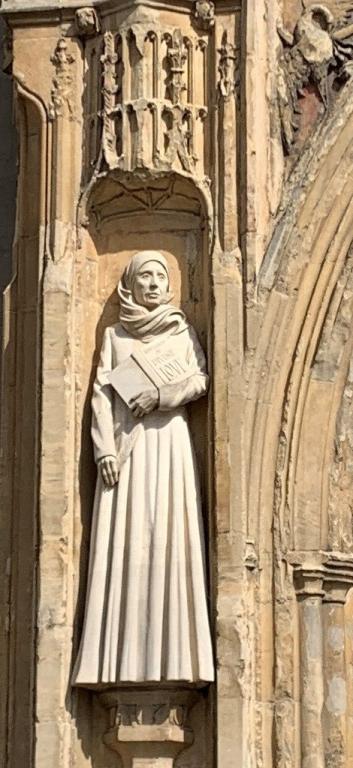
I drove this point home in The Making of Biblical Womanhood, emphasizing that medieval Christians did not ignore the feminine face of God (pp. 52-53). They picked up on biblical texts referencing not only Paul as mother but also God as mother. As I reminded in the second chapter, “Medieval historian Caroline Walker Bynum was so struck by the frequency of maternal imagery used by male clergy like Bernard of Clairvaux in the twelfth century that she wrote her groundbreaking study, Jesus as Mother: Studies in the Spirituality of the High Middle Ages.” But referencing God as mother wasn’t just a twelfth-century fad. Three centuries later, the medieval tradition of God as mother was still evident. Just listen to the words of Julian of Norwich, a devout late medieval English anchoress and Benedictine nun who dedicated her life to prayer and devotion. This is what she wrote: “As truly as God is our Father so truly is God our mother. Our Father wills, our mother works, our good Lord the Holy Spirit confirms. And therefore it is our part to love our God in whom we have our being, reverently thanking and praising him for our creation, mightily praying to our mother for mercy and pity, and to our Lord the Holy Spirit for help and grace.”
Just because evangelicals have forgotten both the biblical and historical tradition of referencing God as mother doesn’t mean it isn’t there. It just means that we have learned to ignore it.
Yet, for over 1000 years of Christian history, God as mother didn’t scare us.
Y’all, let’s just think about the implications of this. I’m Baptist. My lifetime has witnessed the conservative resurgence as well as the writing of gender hierarchy into the very fabric of Baptist identity (culminating in the 2000 Baptist Faith & Message). If Baptists hadn’t forgotten biblical descriptions of God as Mother, if we hadn’t confused the essence of God with symbolic descriptions of God as Father, would our understanding of women be different? Would we have fallen for John Piper’s claim that Christianity has a masculine feel? Would we be as likely to agree with Al Mohler that God qualified only men as pastors to teach, preach, and lead the church?
I’m a historian, which means I’m better at talking about what did happen rather than what could have happened. I can’t help but think, though, that forgetting the feminine face of God has made it easier for us to also forget other things as well–such as the significant role women played in the ministry of Jesus and the early church.
Stay tuned for next time as we talk about Elizabeth Schrader and the faith of the medieval Mary Magdalene.



